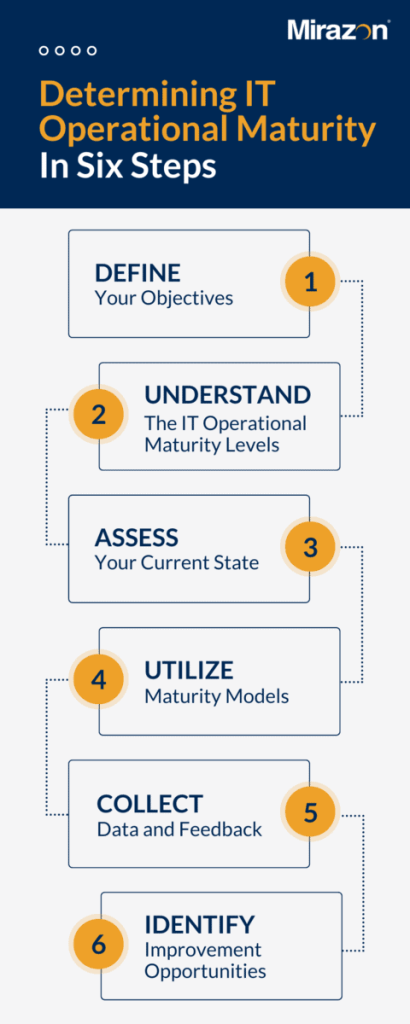
I think we can all agree that, in today’s world, a common goal among organizations is to continually improve their operational efficiency. One way of achieving this goal is by understanding and refining their IT operational maturity level. Here, we’ll explore the process of determining your IT operational maturity level, explain why it’s crucial, and highlight the benefits you’ll reap from it.
What Is IT Operational Maturity?
At its core, IT operational maturity is a comprehensive measure of an organization’s ability to manage and execute its IT operations in a manner that’s not only efficient but also strategically aligned with the overall goals and objectives of the business. This extends beyond the basic functionality of IT systems and dives into the organization’s ability to navigate today’s landscape in a way that promotes growth, resilience, and innovation.
Why Determine IT Operational Maturity?
Understanding your IT operational maturity is crucial for minimizing risks and preventing system failures. It also helps optimize resources by pinpointing areas of potential underutilization. In addition, assessing operational maturity establishes a clear path for ongoing improvement, allowing organizations to responsibly invest in technology and personnel development. This proactive approach not only boosts system reliability but also promotes innovation and adaptability, aligning IT capabilities with changing business needs.
Strategic Alignment
Determining your IT operational maturity level ensures your IT processes and overall strategic goals of the organization align with one another, creating a roadmap for IT to actively support and contribute to the success of the business.
Risk Mitigation
A higher maturity level signifies robust processes and controls, reducing the risk of security breaches, system failures, and operational disruptions. Identifying vulnerabilities early on allows for proactive risk management.
Resource Optimization
By understanding your current maturity level, you can identify areas where resources may be underutilized or overloaded. This enables effective resource allocation and ensures that IT investments align with business priorities.
Continuous Improvement
Determining your maturity level is not a one-time endeavor; it’s a foundation for continuous improvement. Regular assessments provide feedback loops for refining processes, optimizing efficiency, and adapting to evolving technology landscapes.
The Process Of Determining IT Operational Maturity
Step One: Define Your Objectives
Before you begin the process of assessing your IT operational maturity, it’s important to clearly define your objectives. What are the specific goals you want to achieve through this assessment? Whether it’s reducing downtime, improving response times, or enhancing overall IT performance, having a clear vision will guide the evaluation process.

Step Two: Understand the IT Operational Maturity Levels
IT operational maturity is often categorized into different levels, ranging from basic to advanced. This understanding provides context for evaluating your organization’s current state and setting realistic improvement targets. These levels typically include:
- Initial – Ad-hoc processes with minimal control and consistency
- Managed – Basic processes are established, but there’s room for improvement and standardization
- Defined – Processes are documented, standardized, and well-integrated
- Measured – Performance metrics are monitored, and continuous improvement is a focus
- Optimized – Processes are optimized for efficiency, and there’s a proactive approach to improvement
Step Three: Assess Your Current State
To determine your IT operational maturity level, conduct a thorough assessment of your current processes, practices, and capabilities. This evaluation should cover areas such as incident management, change management, problem resolution, guidance, and execution.
Step Four: Utilize Maturity Models
Several maturity models, such as the CMMI and ITIL, can serve as valuable frameworks for assessing and improving IT operational maturity. Choose a model that aligns with your organization’s goals and industry standards (read more about this here).
Step Five: Collect Data and Feedback
Gather relevant data from various sources, including IT performance metrics, user feedback, and cybersecurity incident reports. Analyze this data to gain insights into the effectiveness of your current processes and areas that need more of your attention.
Step Six: Identify Improvement Opportunities
Based on the assessment results, identify specific areas where improvements can be made. Prioritize these opportunities based on their impact on overall operational maturity and align them with your defined objectives from step one.
Benefits Of Determining IT Operational Maturity
Unlocking the full potential of IT operational maturity brings a variety of benefits to organizations. By leveraging a clear understanding of operational maturity, decision-makers can make strategic choices that foster organizational success and resilience – from a business and IT standpoint. This decision-making capability, coupled with increased adaptability and improved customer satisfaction, gives businesses a competitive advantage in today’s landscape of technology.
Enhanced Decision-Making
Informed by a clear understanding of operational maturity, decision-makers can make strategic choices that drive organizational success and resilience in the face of challenges.
Increased Adaptability
Higher maturity levels enable organizations to adapt swiftly to technological changes, market shifts, and emerging trends, ensuring that IT remains a proactive driver of business success.
Improved Customer Satisfaction
Efficient IT processes lead to improved service delivery and customer satisfaction. Understanding your maturity level helps identify and address pain points that may impact end-users.
Competitive Advantage
Organizations with higher IT operational maturity levels are better positioned to outperform competitors. This advantage stems from optimized processes, reduced risks, and a focus on continuous improvement.
Conclusion
In essence, IT operational maturity is a multidimensional concept that goes beyond the technical aspects of IT and captures the organization’s ability to leverage technology as a strategic asset. Understanding and enhancing this maturity level not only provides valuable insights into organizational efficiency and resilience, but also sets the stage for strategic improvements. Reach out to us today if you’re interested in learning more about how to determine and/or improve your IT operational maturity level.
If you’re interested in learning more about your business’s IT operational maturity level, please contact us by calling (502) 240-0404 or emailing info@mirazon.com.